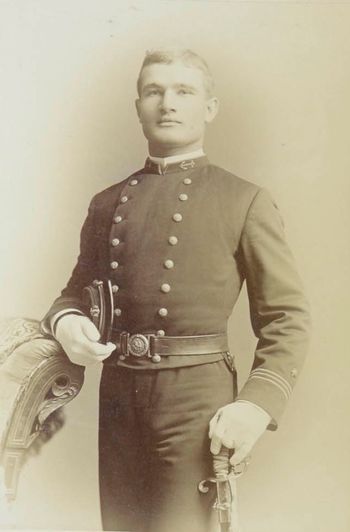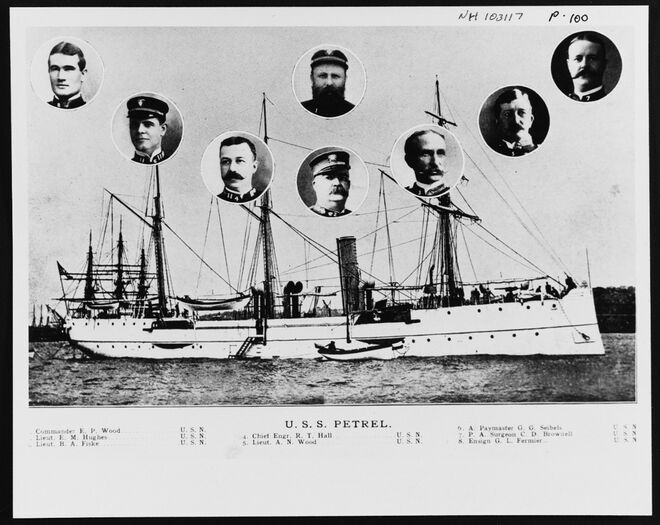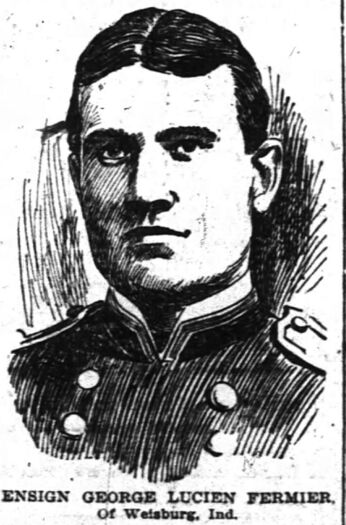GEORGE L. FERMIER, ENS, USN
George is currently listed with his classmates in Memorial Hall. However, we have recommended to the Memorial Oversight Committee at the US Naval Academy that he be removed for the reason listed at the bottom of this page; his loss was not due to hostile action or the result of his military duties.
His entry remains below so we do not lose his memory or the knowledge of his life and service.
George Fermier '89
George Lucien Fermier was admitted to the Naval Academy from Indiana on May 21, 1885 at age 17 years 2 months.
Prior to the publication of the Lucky Bag in 1894, most portraits of officers and midshipmen of the Naval Academy were captured in yearly photo albums. The album for 1889 is available in the collections of the Naval Academy's Digital Collections.
Special thank you to historian Kathy Franz for identifying this resource and then extracting several dozen photographs for this site.

Prior to the publication of the Lucky Bag in 1894, most portraits of officers and midshipmen of the Naval Academy were captured in yearly photo albums. The album for 1889 is available in the collections of the Naval Academy's Digital Collections.
Special thank you to historian Kathy Franz for identifying this resource and then extracting several dozen photographs for this site.
Loss
George died of "stomach ailments" on November 19, 1898 while aboard USS Petrel (Gunboat No. 2) in Shanghai, China.
Other Information
From researcher Kathy Franz:
The Brooklyn Daily Eagle on June 11, 1889, reported that all cadets graduated except for George who had been drinking hard as the result of a love scrape. He was confined to the prison ship Santee.
In June 1890, George along with classmate Julius Prochazka were detached from the Kearsage and ordered to the Baltimore.
In June 1895, George was an ensign on the four-month summer cruise of the Pennsylvania Nautical School. The crew and 80 students went to the Azores, England, France, and Portugal.
In December 1896, he was detached from the Saratoga and ordered to the Petrel.
Per the Sacramento Union, January 24, 1899: “Commander E. P. Wood says of him: “He personally handled and fired the guns of which he had charge, which duty he performed coolly and efficiently. He also destroyed a number of the Spanish vessels after the battle of Cavite, and in his death the navy has lost a gallant officer whose social and military accomplishments would reflect much credit on the naval service.”
“A funeral service with all military honors was held at Shanghai in the municipal crematorium chapel November 22, 1898. The religious services were conducted by Rev. M. Bentley, an American missionary. A firing party was present from the Monocacy. The escort was from his own division of men from the Petrel. The English Government sent four representatives, and Russia, Austria, Italy and Germany each two representatives, and the personal aid-de-camp of Prince Henry of Prussia. Most beautiful floral tributes were sent by the various nations, officers and friends.
“After the body had been cremated the ashes were sent to the United States on the steamer China, and were met at San Francisco and brought to Weisburg by Emil Fermier, a brother of Ensign Fermier.”
He is buried in Indiana.
From The Dearborn County Register, Lawrenceburg, Indiana, July 14, 1898:
An Account of the Battle of Manila by one of the Participants.
By the courtesy of Prof. E. J. Fermier, now spending his vacation at Weisburg, we are able to publish the following report of the battle of Manila just recently received from his brother, Ensign George L. Fermier, an officer of the Petrel, the brave little ship in Admiral Dewey’s fleet, which was in the thickest of that fight:
A state of war having been declared existing between the United States of North America and Spain, the British Government instructed the Governor at Hong Kong to allow the United States naval forces, on the Asiatic station, then at Hong Kong, to remain there not later than 2 p.m., April 25th. Accordingly the vessels that were ready on the 24th left on that date for Miers Bay, China, the other vessels proceeded to Miers Bay on the morning of April 25th.
For several weeks preparations had been made to get the vessels on a war platform. The vessels were put in their war paint – a greenish mud color – they were overhauled, coaled, provisioned and extra ammunition stowed in their magazines.
Two transports were secured, one the Naushau with 3050 tons Cardiff coal and the other the Zifaro which plie between Manilla and Hong Kong. The Ziforo was used for provisions for the fleet. The McCulloch of the revenue service acted as convoy – especially during the battle.
On the 27th we were ready and all instructed, to be prepared to get under way at 2 p.m. The morning paper bringing:
EXTRAORDINARY PROCLAMATION BY THE GOVERNOR-GENERAL OF THE PHILIPPINES.
SPANIARDS: -- Between Spain and the United States of North America hostilities have broken out. The moment has arrived to prove to the world that we possess the spirit to conquer those, who, pretending to be our friends, take advantage of our misfortunes and abuse our hospitality, using means which civilized nations count unworthy and disreputable.
The North American people, constituted of all the social excrescences, have exhausted our patience and provoked war with their perfidious machinations, with their acts of treachery, with their outrages against the law of nations and international conventions.
The struggle will be short and decisive. The God of Victories will give us one as brilliant and complete as the righteousness of our case demands. Spain, which counts upon the sympathies of all the nations, will emerge triumphantly from this new test, humiliating and blasting the adventures from those States that, without cohesion and without a history, offer to humanity only infamous traditions and the ungrateful spectacle of chambers in which appear united insolence and defamation, cowardice and cynicism.
A squadron, manned by foreigners, possessing neither instruction nor discipline, is preparing to come to this archipelago with the ruffianly intention of robbing us of all that means life, honor and liberty. Pretending to be inspired by courage of which they are incapable, the North American seamen undertake as an enterprise capable of realization the substitution of Protestantism for the Catholic religion you profess, to treat you as tribes refractory to civilization, to take possession of your riches as if they were unacquainted with the rights of property, and to kidnap those persons whom they consider useful to man their ships or to be exploited in agricultural or industrial labor.
Vain designs! Ridiculous boasting! Your indomitable bravery will suffice to frustrate the attempt to carry them into realization. You will not allow the faith you profess to be made a mock of impious hands, to be placed on the true temple of God, the images you adore to be thrown down by unbelief. The aggressors shall not profane the tombs of your fathers, they shall not gratify their lustful passions at the cost of your wives and daughters’ honor, or appropriate the property that your industry has accumulated as a provision for your old age. No, they shall not perpetrate any of the crimes inspired by their wickedness and covetousness, because your valor and patriotism will suffice to punish and abase the people that, claiming to be civilized and cultivated, have exterminated the natives of North America instead of bringing to them the life of civilization and progress.
Philippinos, prepare for the struggle and, united under the glorious Spanish flag, which is covered with laurels, let us fight with the conviction that victory will crown our efforts and to the calls of our enemies let us oppose with the decision of the Christian and the patriotic cry of ‘Viva Espana.’
Signed: Your General, Basilio Augustin Davila, Manila, 23rd April, 1898.
Promptly at 2 p.m., April 27, all anchors were hove up and secured for sea. The vessels were put in column and steamed out to sea on the course southeast by east. On our way over to the Philippines every preparation was completed for action, clearing away all stanchions, ladders, unnecessary gratings, chests, paints, oils and in fact all inflammables.
At 3 a.m., April 30th land was sighted ahead and the course changed to the southward following the coast close enough to detect any vessel that might be “stowed away” in some little bay. At 4:50 a.m. the Concord and Boston were ordered to proceed with dispatch to reconnoitre in Subic bay, twenty miles to the southward of the fleet, which bay was reported well stocked with torpedo mines and a harbor for three gunboats or small cruisers which were to leave for Spain immediately after we would pass the bay. Later, at about 9 a.m., the Baltimore was ordered to join the Boston and Concord.
The remaining ships and the reserve cruised along at 8 knots and at about five o’clock found the three vessels at anchor off Subic bay. A careful inspection showed that no Spanish vessels were in the bay; no torpedo mines were struck. The vessels at anchor got underway and took their positions in column. The vessels now cruised in the following order Olympia (flagship), Baltimore, Raleigh, Petrel, Concord, Boston, McCulloch, Manshan and Ziforo, all steaming, and other, save the stern lights were extinguished. Due to the peculiar color of the vessels and the semi-cloudy sky one vessel could scarcely be detected by the one next ahead. Our cruising column was about two miles long.
At 11 p.m. we arrived at the entrance to Manila bay. Carefully and quietly the Olympia piloted into the bay. The fleet following as carefully and quietly for we knew the guns were ready to fire upon us from the Corregidor battery which consisted of four 4.7 inch guns. We were expected to go through Boca Chica, or the small entrance, consequently the Corregidor battery pointed across that entrance; however we took the “Boca Granda” and evaded the Corregidor battery. Both entrances were planted with torpedo mines, but fortune favored us and we passed through untouched, passing El Fraila Island at 11:50 p.m. close aboard, and not until the flames from one of the vessels were seen were we detected. The stern light every vessel carried made it appear to the people on El Fraila that we were coming out, therefore the battery was directed toward the vessels’ lights thus firing at more distant vessels than those abreast of the island. All hands were at general quarters ready for anything that might happen. Suddenly, at twenty minutes past twelve, May 1st, early morning shots were fired at the fleet. The Raleigh, Concord and Boston gave a shot per ship toward the island, again came a shot from El Fraila, again spoke the guns of the Raleigh, Boston and Concord; the battery at El Fraila was quiet after the Concord fired her last shot.
During the night the vessels steamed along very slowly in order to reach our fighting grounds at early morning. Every heart felt a slight trembling during moments of wakefulness until five o’clock when we saw the Spanish fleet off Cavite, some at anchor, some moored and some steaming very slowly waiting for “the squadron manned by foreigners, possessing neither instruction nor discipline.” Being at general quarters and cleared for action there was no need of delay. Daylight came at 5:20 the battery from Manila fired at the fleet, the shot fell but twenty yards ahead off the Petrel; the Petrel held fire by the Concord at 5:22 a.m., May 1st, fired the first shot of the fleet in the “Battle of May 1st, 1898, off Cavite, Manila Bay.” Steaming toward the eastward the Olympia did not change her course until the Spanish fleet bore about southwest when she turned and steamed along to the southward and westward was saluted with the guns of the Spanish fleet of the Canacao battery. All were waiting for the Olympia, when a cloud of smoke and a roar came from one of the 8 in. guns her forward turret, shortly the 2nd 8 in. was fired, the other vessels in turn got the guns to bear on the enemy and by 5:45 all the vessels were having plenty to do.
Steaming along, by the time we passed the Spanish fleet, two or three vessels had been taken behind the breakwater to extinguish the flames set to them by our exploding shell. Having passed the Spanish fleet and battery at Canacao the Olympia steamed on and took the lead again steaming in an ellipse to the eastward and again leading the U. S. vessels by the enemy, allowing all the ships full sway. By the time we completed our second trip it was evident that we had gained a victory over the Spanish fleet, and at 7:45 the U. S. fleet steamed out to A. position (clear of the enemie’s guns) and had breakfast for all hands. And allow it to be known Uncle Sam’s sailors will fight whether they have had breakfast or not.
Upon signaling to the various vessels it was learned that all the vessels except the Concord and Petrel had been struck. A shell striking one of the Baltimore’s guns injured six men, the only injuries sustained during two hours and twenty-three minutes of engagement.
While at breakfast we saw the result of our firing. Vessels were expending themselves in smoke. A cabinet meeting of the commander-in-chief and the commanding officers was held and at this meeting it was decided to re-engage the enemy. Accordingly at 11 o’clock the Baltimore was sent in the lead to go as near as possible to the guns at Canacao and if possible to silence them. Approaching the battery from the northward and westward the forward 8 in. guns pour 250 lbs. of metal into the battery at each discharge. Again and again the shore battery fired at the Baltimore at very short range but not once was she hit. The six wounded men caused the rest of the Baltimore’s crew to fight the guns quicker and harder. Soon the ship was in a cloud of smoke and was obliged to steam ahead, the Olympia coming up to try her 8 in. guns at the battery. She with the Raleigh and Boston quieted what the Baltimore had not. In the meantime the Petrel steamed close in and sent another Spanish ship to the bottom. There remained behind the building and breakwater three vessels that had been in the engagement.
The flagship signaled to the Petrel, “Go inside,” she being the only vessel that could go close in. The eyes of the people of five ships were now turned toward the smallest of the fleet. Inside lay four gunboats and cruisers and one dispatch boat, also a transport and an unfinished cruiser. All save the unfinished cruiser had their batteries on board.
The “Petrel” – Yes, she is the “Stormy Petrel” – kept up her good work. A shot directed to the Commandant’s building succeeded in breaking up the breakfast party and bringing a white flag to the flagstaff and the Spanish flag down.
A signal from the captain of the Petrel stopped all firing. The International flags were then used asking the station to surrender. Both naval and military surrendered the same day. The Petrel then destroyed by fire all vessels save the transport Manila, which, with a half dozen steam launches, is being kept.
The Baltimore, Olympia, Boston and Raleigh returned to station “B” and were joined by the Concord after she set fire to transport “Mindano.” At 7 p.m. the Petrel joined the fleet, while the Boston and Concord took a position off Cavite for picket duty.
The exact number of dead of wounded can not be ascertained now but the two will nearly reach 1100 for the Spanish and six wounded for the United States forces.
Commander Edward P. Wood commands the Petrel and is now known as John Paul Jones.
The Spanish vessels were: Reina Cristina, Castilla, Don Antonia d’Ulloa, Don Juan de Austria, Isle de Luzon, Isle de Cuba, Gen Lezo, Marques del Duero, Correo, Velasco, Mindano, and Manila. The first three were burned in action, the next eight after surrender, and the Manila was kept.
[NOTE: misspellings in original text have mostly been corrected.]
Career
From the Naval History and Heritage Command:
Naval Cadet, 21 May, 1885. Ensign, 1 July, 1891. Died 19 November, 1898.
Photographs
"Fine-screen halftone reproduction of a pre-Spanish-American War photograph of the ship, with vignette portraits of her officers at the time of the 1 May 1898 Battle of Manila Bay. The officers' names and ranks are listed below the image. Copied from the book The Battle of Manila Bay ... An Epic Poem by Pay Director William W. Galt, U.S.N., published in 1900. U.S. Naval History and Heritage Command Photograph."
Memorial Hall Error
Illness is not a criteria for inclusion in Memorial Hall.

